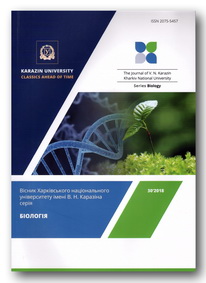Вплив стимулятора росту зеатину на регенераційну здатність рослин деяких видів роду Physalis в культурі in vitro
Анотація
Метою роботи було виявлення ефективного культурального середовища для регенерації видів роду Physalis в умовах in vitro для їх подальшого розмноження і отримання плодоносних рослин з регенерантів в умовах ex vitro. Рослинним матеріалом для дослідження були такі види рослин: Physalis peruviana L., Physalis ixocarpa Broth. (cv. Likhtaryk), Physalis pubescens L. (cv. Zarynka). Введення рослин у культуру та отримання регенерантів проводилися в умовах in vitro; укорінення дорослих рослин та отримання рослин зі зрілими плодами проводили в умовах теплиці та відкритого ґрунту (ex vitro). Для отримання регенерантів використовували середовище Мурасіге і Скуга (МС30), доповнене стимулятором росту зеатином у концентрації 0,5–3 мг/л. Для подовження стебел регенерантів використовували стимулятор росту 6-бензиламінопурин (БАП), а для ініціації коренеутворення використовували стимулятор росту α-нафтилоцтову кислоту (НОК). Як показники ефекту різних концентрацій стимулятора росту зеатину на регенераційну здатність фізалісів використовували такі критерії: частоту регенерації рослин і кількість регенерантів, які регенерували з одного експланту. Після проведення серії експериментів були підібрані ефективні поживні середовища для регенерації P. peruviana, P. ixocarpa (cv. Likhtaryk), P. pubescens (cv. Zarynka). Найбільш ефективними середовищами для регенерації пагонів із сім’ядольних листкових експлантів виявились MС30 + 1 мг/л зеатину (Зеа) і MС30 + 2 мг/л Зеа. Регенерація на цих середовищах складала для P. ixocarpa (cv. Likhtaryk) – 46,15 % і 53,84 %, для P. peruviana – 38,46 % і 45 %, для P. pubescens (cv. Zarynka) – 27 % і 34 % відповідно. Отримані регенеранти відокремлювали від експлантів і переносили на середовище MС30, доповнене 1 мг/л БАП + 0,1 мг/л НОК для росту стебел та вкорінення. Через місяць культивування на середовищі MС30 + 1 мг/л БАП + 0,1 мг/л НУК були отримані ювенільні рослини, які були перенесені в тепличні умови для проходження адаптації, а пізніше – у відкритий ґрунт на експериментальній ділянці. Через три місяці (з моменту появи регенерантів) були отримані фертильні рослини, які квітували і плодоносили. Нами вперше були отримані регенеранти для вітчизняних сортів P. ixocarpa (cv. Likhtaryk), P. pubescens (cv. Zarynka). Знайдена пряма залежність між концентрацією зеатину і частотою регенерації рослин, а також між концентрацією зеатину і кількістю регенерантів, отриманих з одного експланта.
Завантаження
Посилання
Afroz F., Sayeed Hassan A.K.M., Shamroze Bari L. et al. (2009). In vitro shoot proliferation and plant regeneration of Physalis minima L. – a perennial medicinal herb. Bangladesh J. Sci. Ind. Res., 44(4), 453–456. https://doi.org/10.3329/bjsir.v44i4.4597
Assad-García N., Ochoa-Alejo N., García-Hernández E. et al. (1992). Agrobacterium-mediated transformation of tomatillo (Physalis ixocarpa) and tissue specific and developmental expression of the CaMV 35S promoter in transgenic tomatillo plants. Plant Cell Reports, 11, 558–562. https://doi.org/10.1007/BF00233092
Bergier K., Kuźniak E., Skłodowska M. (2012). Antioxidant potential of Agrobacterium-transformed and non-transformed Physalis ixocarpa plants grown in vitro and ex vitro. Postepy higieny i medycyny doswiadczalnej (Online), 66, 976–982. https://doi.org/10.5604/17322693.1023086
Gupta P.P. (1986). Regeneration of plants from mesophyll protoplasts of ground berry (Physalis minima L.). Plant Sci., 43, 151–154.
Kumar O., Ramesh S., Tata S. (2015). Establishment of a rapid plant regeneration system in Physalis angulata L. through axillary meristems. Notulae Scientia Biologicae, 7(4), 471–474. https://doi.org/10.15835/nsb749707
Lemmon Z.H., Reem N.T., Dalrymple J. et al. (2018). Rapid improvement of domestication traits in an orphan crop by genome editing. Nature Plants, 4, 766–770. https://doi.org/10.1038/s41477-018-0259-x
Mungole A.J., Doifode V.D., Kamble R.B. et al. (2011). In vitro callus induction and shoot regeneration in Physalis minima L. Annals of Biological Research, 2(2), 79–85.
Murashige T., Skoog F. (1962). A revised medium for rapid growth and bioassays with tobacco tissue cultures, Physiol. Plantarum, 15, 473–497. https://dx.doi.org/10.1111/j.1399-3054.1962.tb08052.x
Otroshy M., Mokhtari A., Khodaee S.M.M., Bazrafshan A.-H. (2013). Direct regeneration from leaves and nodes explants of Physalis peruviana L. Intl J Farm & Alli Sci., 2(9), 214–218.
Patel G.K., Bapat V.A., Rao P.S. (1987). Protoplast culture and genetic transformation in Physalis minima L. Proc. Indian Acad. Sci. (Plant Sci.), 97(4), 333–335.
Rakhmetov D.B., Korablyova O.A., Stadnichuk N.O. et al. (2015). Catalog of plants of the department of new crops: NAS of Ukraine, M.M. Gryshko National Botanical Garden. Kyiv: Phytosociocenter, 112 p. (In Ukrainian)
Ramar K., Ayyadurai V. (2014). In vitro regeneration of Physalis maxima (Mill) an important medicinal plant. Int. J. Curr. Microbiol. App. Sci., 3(12), 253–258.
Ramar K., Ayyadurai V., Arulprakash T. (2014). In vitro shoot multiplication and plant regeneration of Physalis peruviana L. an important medicinal plant. Int. J. Curr. Microbiol. App. Sci., 3(3), 456–464.
Rao Y.V., Shankar A.R., Lakshmi T.V., Rao K.R. (2004). Plant regeneration in Physalis pubescens L. and its induced mutant. Plant Tissue Cult., 14(1), 9–15.
Sandhya H., Srinath R. (2015). Role of growth regulators on in vitro callus induction and direct regeneration in Physalis minima Linn. International Letters of Natural Sciences, 44, 38–44. https://doi:10.18052/www.scipress.com/ILNS.44.38
Sheeba E., Palanivel S., Parvathi S. (2015). In vitro flowering and rapid propagation of Physalis minima Linn. – a medicinal plant. International Journal of Innovative Research in Science, Engineering and Technology, 4(1), 18763–18768. https://doi:10.15680/IJIRSET.2015.0401057
Singh P., Singh S.P., Shalitra R. et al. (2016). In vitro regeneration of cape gooseberry (Physalis peruviana L.) through nodal segment. The Bioscan, 11(1), 41–44. https://doi:10.13140/RG.2.2.13622.50241
Swartwood K., Van Eck J. (2019). Development of plant regeneration and Agrobacterium tumefaciens-mediated transformation methodology for Physalis pruinosa. Plant Cell Tiss Organ Cult, 137, 465–472. https://doi.org/10.1007/s11240-019-01582-x
Yaroshko O., Kuchuk M. (2019). Direct plant regeneration from Physalis peruviana L. explants. Biotechnologia Acta, 12(2), 56–52. https://doi.org/10.15407/biotech12.02.056
Автори залишають за собою право на авторство своєї роботи та передають журналу право першої її публікації на умовах ліцензії Creative Commons Attribution License 4.0 International (CC BY 4.0), яка дозволяє іншим особам вільно розповсюджувати опубліковану роботу з обов'язковим посиланням на авторів оригінальної роботи.




